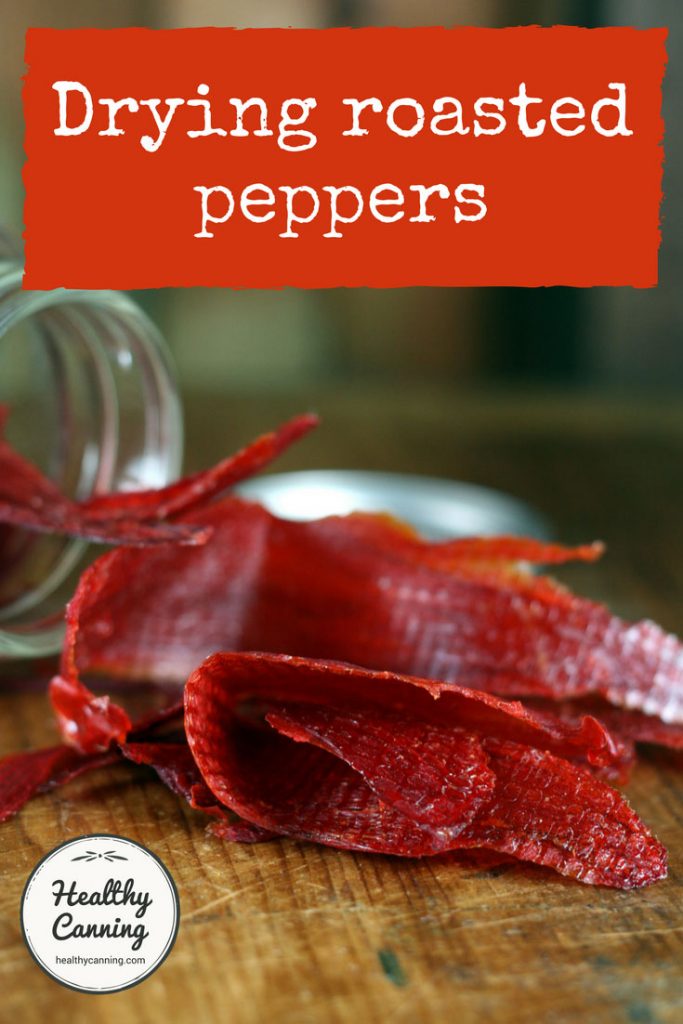Roasting peppers before dehydrating them is more work than dehydrating them from “fresh”, but it can give them a more complex flavour.
Note: most University Cooperative Extension Services recommend that for best quality, roasted peppers are best stored by freezing. Dr Linda Harris from the University of California writes, “Freezing is the preferred method to preserve roasted peppers.” [1]Harris, Linda J. Peppers. University of California DANR. Publication 8004. 1998.
That being said, there can be reasons still for dehydrating roasted peppers. For instance, for turning it into a savoury powder to be used as a spice.
See also: Canning roasted peppers.
Yields and Equivalents
1 kg (2 lbs) fresh red shepherd peppers (as purchased, 5 peppers) = 75 g (2.5 oz) roasted, seeded and peeled dehydrated red pepper pieces
Directions
1. Prep, roast and peel the peppers
Line rimmed baking sheets (balance as many as you think you will need with as many as you can fit in oven at one time) with tin foil (optional but makes cleanup far easier.) Set aside.
Wash, stem, seed the peppers.
Put on ungreased baking sheet surface cut side down.
Roast at 190 C (375 F) for about 25 to 30 minutes, until the skin on some of them begins to char. (How long exactly will depend on how hot your oven runs.)
Remove from oven, let cool for about 10 to 15 minutes or until cool enough to handle safely.
The skin will be wrinkled. Pinch it at one end, and most of the time you will be able to pull it away entirely from the pepper in one go.
If the skin isn’t that wrinkled, then you need to roast longer. If the skin sticks a lot, then you need to let it cool a bit more.
Using the above method, budget in your mind about 2 hours prep work per half US bushel (5 kg / 11 lbs) of peppers.
2. Dehydration
Follow one of the three recommendations for dehydrating sweet peppers.
Turn them over, and rotate the trays 90 degrees once or twice during the drying process.
When they are fully dried, expect to see them extremely thin, almost like paper. They will have a texture halfway between leathery and brittle.
Notes
Tough-skinned peppers, such as New Mexico Green Chiles (aka long green chiles), must always be roasted before dehydrating in order to remove their skins, as their skins otherwise are just so tough as to render the chile unpalatable in a dish.
Storage
Let the dehydrated product cool completely to room temperature before packing it into storage containers.
Watch the sealed containers for the first few days for any sign of condensation. If condensation occurs, dehydrate a bit more.
Label jar with name of product and date. Store away from heat and direct light.
DO NOT store in oil. The risk factor in doing that is botulism.
Usage notes
Use in casseroles, pasta sauces, rice dishes, etc.
Or, grind up and use as a spice.
To rehydrate:
Cover with cold water and soak 30 to 90 minutes, or cover with boiling water and soak 20 to 60 minutes.” [2]P. Kendall, P. DiPersio and J. Sofos. Drying Vegetables. Colorado State University Cooperative Extension. Publication no. 9.308. July 2004. Page 2
References


Wondo
I use parchment paper instead of foil. It is a much better environment solution and takes far less space in the landfill. I garden but do not have a workable compost due to lack of adequate material to generate heat, therefore I do not know if all parchment papers can be composted. I also roast tomatoes on parchment. I cut paper to extend beyond the corner of a low rimmed pan or pizza pan. I push the paper down in the corner. As soon as they have roasted – or half way roasted if juicy tomatoes – I pour off the juice,. For both peppers and tomatoes After roasting I cover with another paper and lay potholders over to hold it down. When cooled tomato skins can be quickly plucked off. Pepper skins seem to depend on the amount of flesh or variety. Many are just fine with skins left on. I’m totally sold on roasting peppers, tomatoes and all non-leafy veggies. Roasting in glass casserole dishes with lids allows root crops to marry their flavours. YUM!